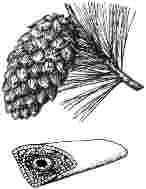
Pinus flexilis (5).
|
Pinus flexilis
E. James 1823
Common NamesLimber pine, limbertwig, Rocky Mountain pine (6), pino (7), white pine (8), pin blanc de l'ouest (9).Taxonomic notesSyn: Apinus flexilis (E. James) Rydberg (9). One variety, Pinus flexilis var. reflexa Engelmann 1879 (syn: P. reflexa (Engelmann) Engelmann 1882; P. ayacahuite var. strobiformis Lemmon 1892; P. ayacahuite var. reflexa (Engelmann) Voss 1907; P. flexilis subsp. reflexa (Engelmann) Murray 1982 (11). Section Cembra (7).Farjon and Styles (11) regard P. flexilis and P. strobiformis as forming a polymorphic clone, while Perry (7) regards them as distinct taxa with introgression in their shared range. The difference is largely academic; both taxa certainly exhibit clinal variation and hybridize within their shared range. DescriptionTrees 12-15(26) m tall; 60-90(200) cm diameter, straight to contorted; crown conic, becoming rounded; growth form may be substantially deformed near timberline. Bark light grey, nearly smooth, becoming dark brown and cross-checked in age into scaly plates and ridges. Branches spreading to ascending, often persistent to trunk base; twigs pale red-brown, puberulous (rarely glabrous), slightly resinous, aging gray, tough and flexible, smooth. Buds ovoid, light red-brown, 0.9-1 cm, resinous; lower scales ciliolate along margins. Needles 5 per fascicle, spreading to upcurved and ascending, persisting 5-6 years, 3-7 cm × 1-1.5 mm, pliant, dark green, abaxial surface with less conspicuous stomatal bands than adaxial surfaces, adaxial surfaces with strong, pale stomatal bands, margins finely serrulate, apex conic-acute to acuminate; sheath 1-1.5(-2) cm, shed early. Staminate cones broadly ellipsoid-cylindric, ca. 15 mm, pale red or yellow. Ovulate cones maturing in 2 years, shedding seeds and falling soon thereafter, spreading, symmetric, lance-ovoid before opening, cylindro-ovoid when open, 7-15 cm long, yellow-brown, resinous, sessile to short-stalked, apophyses much thickened, strongly cross-keeled, umbo terminal, depressed. Seeds irregularly obovoid; body 10-15 mm, brown, sometimes mottled darker, wingless or nearly so. 2 n =24 (8, 9).RangeRocky Mountains and Intermountain Ranges from Canada: SE British Columbia and SW Alberta, S through USA: Oregon, Idaho, Montana, North Dakota, South Dakota, Nebraska, Wyoming, Colorado, Utah and Nevada to N New Mexico and W through N Arizona to S California at (1000)1500-3700 m, preferring dry, rocky slopes and ridges of high mountains up to timberline, often occurring in pure stands (8, 9). See also (13). Var. reflexa may occur in the USA: Arizona, New Mexico and W Texas (populations identified as P. strobiformis ), and is known from a few locales in Mexico (Chihuahua, Coahuila and S Nuevo León) but may have a more extensive range in that country (11).Big TreeHeight 18 m, dbh 222 cm, crown spread 14 m. Locality: On a ridge S of Snowbird, Utah (12).OldestCrossdated ages of 1,670 years from site ERE in New Mexico, collected by Swetnam and Harlan; and 1659 years for specimen KET3996 from Ketchum, Idaho collected by Schulman in 1956 (4). Given the fact that crossdated tree ages are always underestimates because of the near-impossibility of sampling the tree's seedling growth years, either of these trees could have been the older, particularly since KET3996 was sampled about 30 years before the ERE tree.DendrochronologyAn important species due to its longevity and widespread occurrence in the arid U.S. Numerous citations.EthnobotanyObservationsSeen in much of its range. Sampled a near-timberline grove in the Medicine Bow Mountains of Wyoming, where it is a timberline species. Could not locate any trees older than about 300 years. Visited an impressive timberline grove on Borah Peak, ID, located on the main Borah Peak climber's trail and a worthy objective for photographers. Visited Craters of the Moon National Monument in ID, which has numerous groves and an interesting history. One of the oldest limber pines ever found was sampled there in the 1930s and has since died. Many other ancient limber pines in the monument were killed by the Park Service in the early 1960s in a poorly conceived attempt to eradicate a mistletoe infestation.RemarksWhite pine blister rust ( Cronartium ribicola ), an introduced fungal disease, has afflicted this and certain other white pines (5).The common name "limber" refers to the tough, flexible twigs. The seeds are an important food source for rodents and certain birds (8). Pinus flexilis "reportedly forms intermediates with P.strobiformis where the two overlap (9). The fresh-cut wood has the odor of turpentine" (9). Citations(1) Silba 1986 .(2) Arno & Gyer 1973 . (3) Elmore & Janish 1976 . (4) Brown 1996 . (5) Elias 1987 . (6) Peattie 1950 . (7) Perry 1991 . (8) Little 1980 . (9) Robert Kral in Flora of North America online . (11) Farjon & Styles 1997 . (12) American Forests 1996 . (13) Robert S. Thompson, Katherine H. Anderson and Patrick J. Bartlein. 1999. Atlas of Relations Between Climatic Parameters and Distributions of Important Trees and Shrubs in North America. U.S. Geological Survey Professional Paper 1650 A&B. URL= http://greenwood.cr.usgs.gov/pub/ppapers/p1650-a/pages/conifers.html , accessed 22-Jan-2000. See also: |
|
[ Pinus ] [ Pinaceae ] [ home ]
This page is from the Gymnosperm Database
|